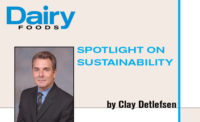The U.S. dairy industry has been diligently gathering data, crunching numbers and double-checking methodologies to ensure that the carbon footprint and life-cycle assessments for fluid milk and cheese are consistent with internationally accepted schemes and protocols. Since we are pretty much done with those, now what?
It is time to cash in — or should I say “create value” — by reducing your carbon footprint. Many folks in the dairy industry have been doing that for longer than the word “sustainability” has been around. But the buzz around sustainability has energized efforts to increase efficiency, reduce waste, reduce greenhouse gases and add to the bottom line like never before.
Check out the Innovation Center for U.S. Dairy’s website (www.usdairy.com) and you will see how busy the industry has been and what we are achieving. The case studies on the impact of switching from incandescent lamps to LED lighting show doing so reduces electrical energy consumed substantially. It also shows LEDs save time and money by reducing maintenance time and costs because they last up to 20 times longer than incandescent lights — LEDs can last up to 40,000 hours.
There is a case study about one of my favorite technologies — thermal solar heat — at Oakhurst Dairy, Portland, Maine. I mentioned this case briefly in my first column (Dairy Foods, January 2011, page 124), but it’s worth a little more ink here. That facility in Maine — yes, Maine — has been saving more than 7,500 gallons of No. 2 fuel oil per year with the potential for improvement. Currently, that represents annual savings of about 224,000 pounds of CO2.
What I like about this project is that it went forward despite having an unusually long payback period. Payback in this case will be eight years versus the industry standard of one to two years that most projects need to get capital funds. After the first eight years, the system will be paid for and should last another 22 years, which will save the company an estimated $350,000 at today’s oil prices. If fuel prices increase, which you and I know they will, the savings grow. So solar can pay out, even in Maine.
Energy audit finds savings
Sometimes value comes not from adding something new, but rather making better use of what you have now. That was the case for an Ohio novelty plant that had multiple air compressors running off local controls. After my friends at Solution Dynamics Inc., Brookfield, Wis., performed an energy audit of the facility, they discovered that adding another air compressor at a cost of $50,000 was not the solution. Instead, they focused on getting the most out of what was already there. They did this by integrating the multiple units, adding larger controlled storage capacity, installing high-efficiency nozzles and other equipment and, of course, fixing leaks. In the end, the company invested a little more than $76,000 with a life expectancy of 10-15 years and an annual cost savings of nearly 850,000 kWh or $38,250. The payback came in at 1.4 years — right in the sweet spot needed to get capital funds.
Value to processors can also be delivered by new refrigeration systems, refrigeration system upgrades or by replacing outdated milk evaporators with reverse-osmosis systems, as was done at the Maryland & Virginia Milk Producers Cooperative’s balancing plant in Laurel, Md., in 2009. Here too, the payback period was unusual for the dairy industry: 4.4 years. But, the company clearly saw the value when it benefited from reduced electrical demand and natural gas usage savings of nearly $500,000 per year. Reduced maintenance on this low-temperature technology was a bonus and it eliminated nearly 2,700 metric tons of CO2. It really drives home the opportunities offered by the dairy industry’s voluntary commitment to reduce greenhouse gas emissions for fluid milk by 25% by the year 2020.
Dive into the motor pool
Delivering value can also come from the transportation side of the dairy industry. Transportation, processing and distribution comprise about 17% of the greenhouse gas emissions associated with a gallon of consumed fluid milk. Raw transportation to processing locations amounts to nearly one-half the amount of greenhouse gas emissions associated with processing. So, there are lots of opportunities to be had. For example, Dairy Farmers of America, Kansas City, Mo., installed a GPS-based electronic fleet management system, which delivered an incredible value. The system delivered data on fuel consumption, route information, inspection data and driver speed, which is wirelessly routed to fleet managers. With a relatively small investment of $138,000 plus $50,000 per year in maintenance for 150 trucks, the payback period was six months. That’s excellent. Annual fuel savings came in at $377,000 — or 94,250 gallons of diesel at an estimated cost of $4 per gallon. This represents an approximate 950 metric tons of greenhouse gas emissions avoided.
While the title and the premise of this column is about capitalizing on value associated with reducing greenhouse gas emissions, readers should not be complacent about water. We will deal with that issue, too, but suffice to say for now: Water saved is greenhouse gas emissions reduced. n




